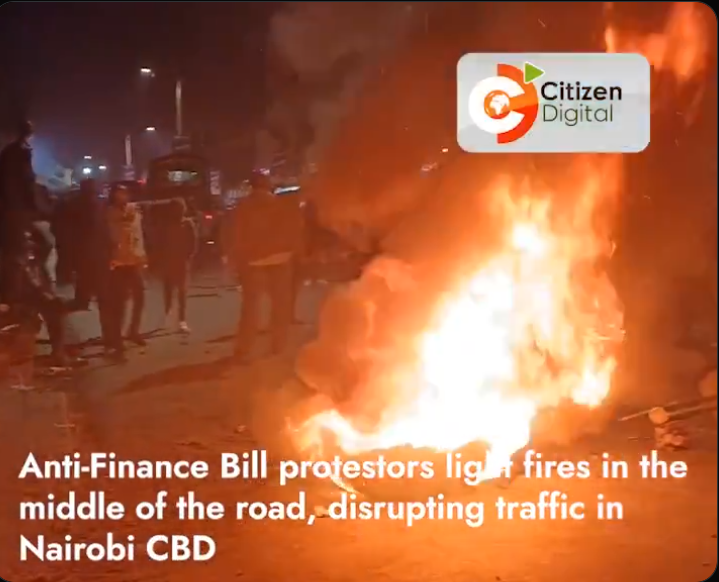The atmosphere in Nairobi’s Central Business District (CBD) has reached a boiling point as anti-Finance Bill protesters escalate their actions, lighting fires in the middle of major roads and causing significant disruption to traffic. The flames and billowing smoke serve as a stark symbol of their anger and frustration, turning the usually bustling streets into chaotic scenes of defiance.
The fires, strategically placed at key intersections, have brought traffic to a standstill, with vehicles unable to navigate through the makeshift barricades. Commuters and drivers find themselves stranded, some choosing to abandon their cars and join the protests, while others seek alternative routes in a desperate bid to reach their destinations. The sight of burning tires and debris adds to the sense of urgency and turmoil gripping the city.
Protesters, emboldened by their numbers and the intensity of their cause, chant slogans and wave placards denouncing the Finance Bill. Their grievances are clear: they view the bill as an oppressive measure that will exacerbate economic hardships for ordinary citizens. The fires are not just a tactic to disrupt traffic but a powerful message to the government about the depth of public dissent.
Amid the chaos, the police struggle to regain control. Water cannons and tear gas are deployed, but the protesters, well-prepared and highly motivated, quickly regroup and resume their actions. The clashes between police and demonstrators are intense, with both sides sustaining injuries. The scene is one of constant movement and confrontation, with neither side willing to back down.
Businesses in the area are heavily impacted, with shops and offices closing early to avoid the unrest. The economic impact of the protests is significant, adding another layer of complexity to the ongoing conflict. Shop owners and workers express their frustrations, caught between supporting the protests and needing to secure their livelihoods.
The fires have drawn national and international attention, with media coverage highlighting the scale of the disruption and the passionate resistance of the protesters. Social media is flooded with images and videos of the burning barricades, further amplifying the protesters’ message and drawing sympathy from a wider audience.
Inside government halls, there is an urgent call for a reassessment of the situation. The administration faces mounting pressure to address the protesters’ concerns and find a way to de-escalate the situation. Political leaders and advisors debate potential responses, from revisiting the contentious Finance Bill to initiating dialogues with protest leaders. The decision-making process is fraught with tension, as the government’s next steps could either calm the situation or further inflame public sentiment.
Watch Now
Read Also
For the protesters, the fires symbolize a turning point in their movement. They are not just fighting against a single piece of legislation but are voicing broader discontent with economic inequality and governance issues. The fires burning in Nairobi’s streets reflect the burning desire for change among the populace, a demand that the government cannot afford to ignore.


